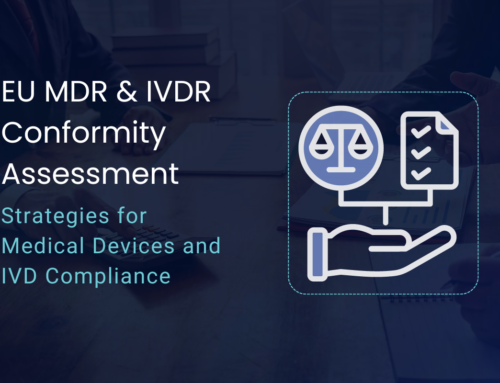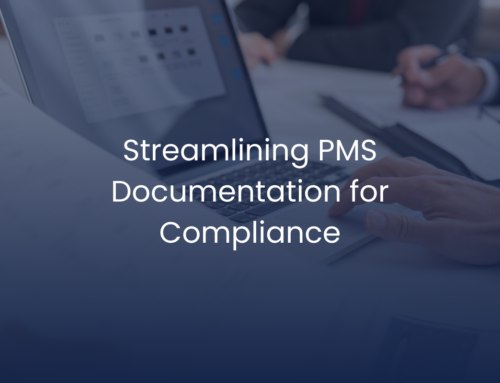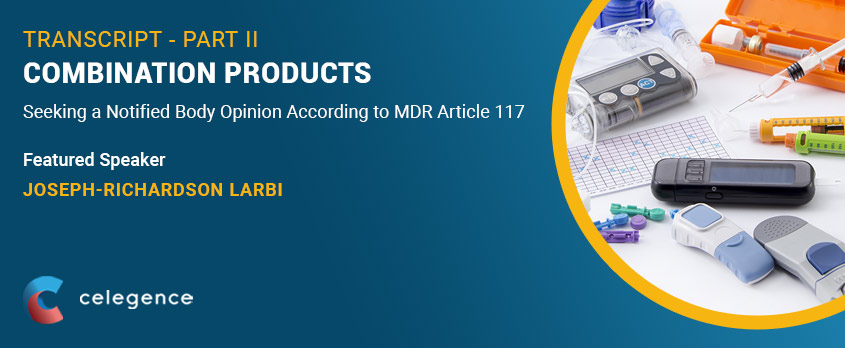
Combination Products: Seeking a Notified Body Opinion according to MDR Article 117 – Transcript – Part 2
Joseph-Richardson Larbi has 18 years of experience in Medical Device (MD & IVD) Regulatory and Quality strategies (from design development to market launch and post marketing activities – compliant to MDD/MDR/IVDR/ISO 13485/9001 Quality Management Systems). He is experienced in MD CE certification, ISO 14971 Risk Management, Manufacturing and Supplier Management, Manufacturing Verification and Validation, Post Market Surveillance, Clinical Evaluation Reports, Drug Device Combinations, regulatory relationship management, and has advanced knowledge of FDA Drugs, Biologics, and Biosimilars (IND, NDA, BLA).
Outlined in Annex 1 of the MDR, the General Safety and Performance Requirements (GSPRs) are required to be met for combination products prior to placing them on the market. The products in scope of this requirement are integral Drug Device Combination products, and products in which both the medicinal product and device are to be used exclusively within the given combination.
During our webinar titled “Combination Products: Seeking a Notified Body Opinion According to MDR Article 117,” Joseph spoke specifically about MDR Annex 1 – GSPRs, the best practices for technical documentation, and reviewed some practical examples.
Why should you read the transcript / watch this video?
- Gain an understanding of the General Safety and Performance Requirements (GSPRs) that must be met for combination products prior to placing them on the market.
- How to best prepare your RA team for Notified Body Opinions under article 117 to ensure a seamless transition.
A full transcript of Joseph’s presentation is available to download (and to read below) and just press play to watch the clip now.

Claim Your Free EU MDR Checklist Now!
Make sure you and your business are compliant with the new EU MDR. Get our 23 page checklist for actionable technical documentation requirements.
Overview of MDR Annex 1 – GSPRs
There are three chapters, and they each have various requirements. They have 23 main requirements, but they have up to 200 considerations. So it is possible for you to have one requirement that then has another 10 sub requirements, or another 10 sub considerations. Manufacturers need to go through the entire 23 main requirements, the three chapters of the GSPRs, and then demonstrate which ones are applicable and which ones are not applicable. For the ones that are not applicable, you have to justify why you think they are not applicable. The notified bodies will be looking out for these statements as well. Keep in mind – not all requirements will be applicable to one particular medical device.
If it’s not sterile, or it’s not emitting radiation, there will be certain areas that will not be applicable to your product. So you have to go through that, and then make sure that you are clearly stating which of these 23 points are applicable, and which ones are not applicable, or the considerations.
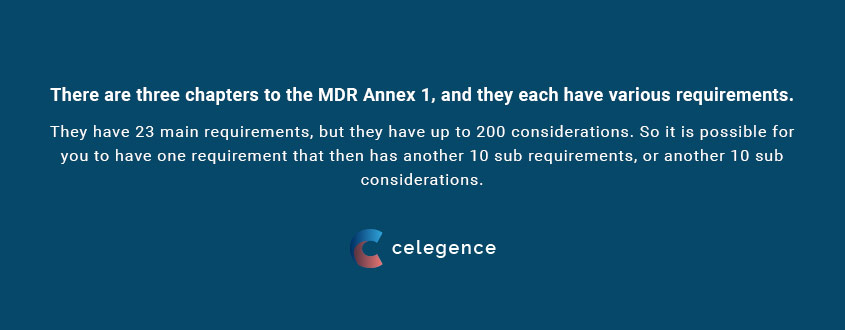
Overview of MDR Annex 1 – GSPRs Chapters
In summary, I just want to give you an overview of what these three chapters are talking about. So I’ve broken that down by chapters 1, 2, 3 and we’ll give you a brief overview of what’s going on in each.
Chapter 1: You’ve got your general requirements, which has 9 main requirements with up to 20 considerations. Now you are to assess the safety and performance elements of how you have designed and manufactured the device, taking into consideration its intended use. So right from the very beginning, you have to consider the intended use, how safe it is, and its performance.
You also need to consider risk management according to ISO 14971, its latest addition at the moment is the 2019 version. Make sure you analyze your risk of events. You evaluate them, you score it, you then control, mitigate, and reduce the risk, and then you evaluate your residual risk. You must define your risk – you are putting measures to reduce it, or to get rid of the risk. And then afterwards, you have to analyze again, you have to evaluate, and find out if you have any residual risk? That’s the review element. And then, you also have to consider your production activities and your post production activities, and then your risk elements associated with that, and then also factor those ones into your risk management.
Chapter 2: This chapter talks about your chemical, physical, and biological properties of the device element. It has 13 main requirements with up to 103 considerations. In this instance we are talking about your design and manufacturing considerations, and choice of materials. Why have you chosen a particular material, the compatibility of any moving parts, and from material A to material B, are these two materials compatible with each other? What are the mechanical properties of these materials? You must be able to state all of these, why you’ve chosen it and its mechanical property. When it comes to toxicity, certain plastics or certain elements getting into contact with the skin, they could have a reaction with the skin.
Chapter 3: This chapter is related to the information supplied with the device. This could be labels that need to go onto the device, or it could be the information for leaflets. It has one main requirement with up to 65 considerations. And these are the things that you need to consider for the labeling of the device and for the information that’s going with the device. There is the sticky situation though for combination products where we have seen that the medicinal side will have your primary mode of action. If you have experienced this, the competent authority usually doesn’t allow a lot of your medical device information to be included on the outer packaging for various reasons. So you have to consult with your MPD – your medicinal product directive and where there are differentiations. I would advise you to go with your medicinal product directives requirements when it comes to labeling.

Claim Your Free EU MDR Checklist Now!
Make sure you and your business are compliant with the new EU MDR. Get our 23 page checklist for actionable technical documentation requirements.
Medical Device Label Requirements MDR
One thing that you will be allowed to do is if your device needs a label, you have to label it according to the MDR. It’s the outer packaging where if it’s a medicinal product, you have to go by the medicinal product directive guidelines. It must be presented as a medicine in that particular combination. When you’ve got a clash between the medical device and your medicines directive, then I would say go by your medicines directive, consult with your competent authority on where you’ve got things that are clashing, and they will be able to assist you. Alternatively, get in touch with Celegence and we’ll be able to help you as well.
Best Practices When Seeking a Notified Body Opinion – General Considerations
So you’ve been assigned to a project for a combination product. You have to identify your combination product, go by the definitions of article 117, article 1 of the MDR section 8, and section 9, including the sub paragraphs of these two sections. Make sure that you are falling within these particular definitions. If you are within it, then does the device element on its own need a separate conformity assessment? It might. If it needs a separate conformity assessment, then you have to get in touch with their notified body and go through a full conformity assessment to get CE Mark on the product. Can you self-certify the device element and affix a CE Mark yourself? If you can’t do any of these, then you need a notified body opinion. If you need a notified body opinion, then you have to make sure that for the device element, you are meeting the requirements of Annex 1 of the MDR, which is the GSPRs.
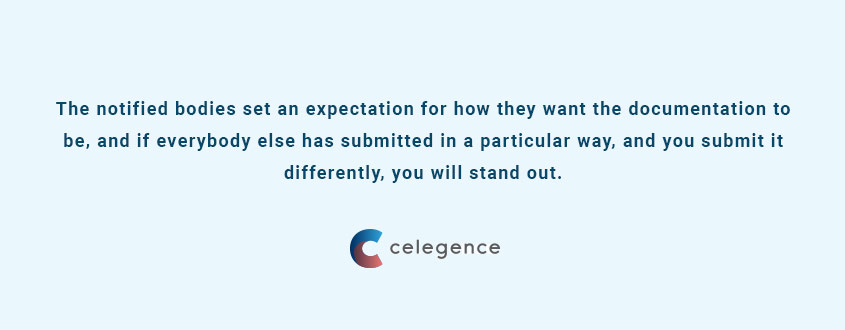
Notified Body Technical Documentation
The notified bodies set an expectation for how they want the documentation to be, and if everybody else has submitted in a particular way, and you submit it differently, you will stand out.
- Cover Letter: Starting off, make sure that you have a cover letter explaining the reason for an assessment. This demonstrates that you know why you’ve approached the notified body, and is where you give them information about your device. Then, they are going to give you a quotation, and will have to have signed a contract and all that comes with that.
- State Clearly what the Intended Use Is: This is a prerequisite for your technical documentation, and then you must state clearly what the intended use is. Don’t let it be too complicated, it has to be clear to the reviewer what the intended use is.
- Device Description: This should include any variants of the particular device, and any accessories that work with the device. Make sure you state all of these in your technical documentation. Make sure you add diagrams and pictures as well. In general, make sure your technical documentation is searchable.
- Design and Manufacturing Information: How the product has been designed, the manufacturing information, the verification and validation processes that you’ve gone through, and the manufacturing protocols need to be laid out well. It’s important for it to be easy for the reviewer to understand.
- Device Verification Validation Process: Make sure that you are utilizing the harmonized standards that are applicable. Some devices are published through harmonized standards by the European commission. I’d suggest – Go to their website, have a look at the harmonized standards for your particular medical device, and make sure you are following that to demonstrate your verification and validation processes, and how safe your device is and to the user and to the patients.
- Demonstrate Strong Risk Assessment Implementation and Maintenance: You will have your risk file which should contain your risk plan and all the things that you’re going to do. How are you going to analyze the risk element of your device? And the sources of information? It could be from your clinical evaluations, post-marketing surveillance, from complaints, from feedback, or from manufacturing. One of the elements of ISO 14971 is to consider your production and post production elements. This is very important, make sure all of these things are linked to your risk management file. Make sure you can demonstrate your benefit-risk ratios. You have to have clear SOPs, policies, supporting documentation, and everything that goes with it to demonstrate that you have thoroughly assessed the risk associated with the device. When you do look at the GSPRs chapter 1, it’s full of risk elements.
- Demonstrate Compliance to the GSPRs: Make sure you list out your GSPRs. Go according to how it is stated within the MDR, make it clear on what is applicable and what is not applicable, and what your justification is for each point and each consideration. Make sure that you submit documentation to prove compliance to every single point or consideration of the GSPRs. Use good referencing systems as well.
Will they have any questions? Yes. During a particular period, they will throw back questions to you for you to answer, they will review your answers, and then they’ll be able to issue you the report if they don’t have any further questions. Just make sure you bear all of this in mind.
Notified Body Opinion – Conclusions
Since 2017, priorities have changed and we’re focusing on different things, but if you do find yourself confused, you don’t know which way to go, then by all means, reach out to Celegence and we will be able to help you accordingly like my colleague said. We have experienced professionals within the industry working in the organization, and we will be able to assist you – so reach out and let us know what your requirements are. We will be able to guide you. Thank you!
